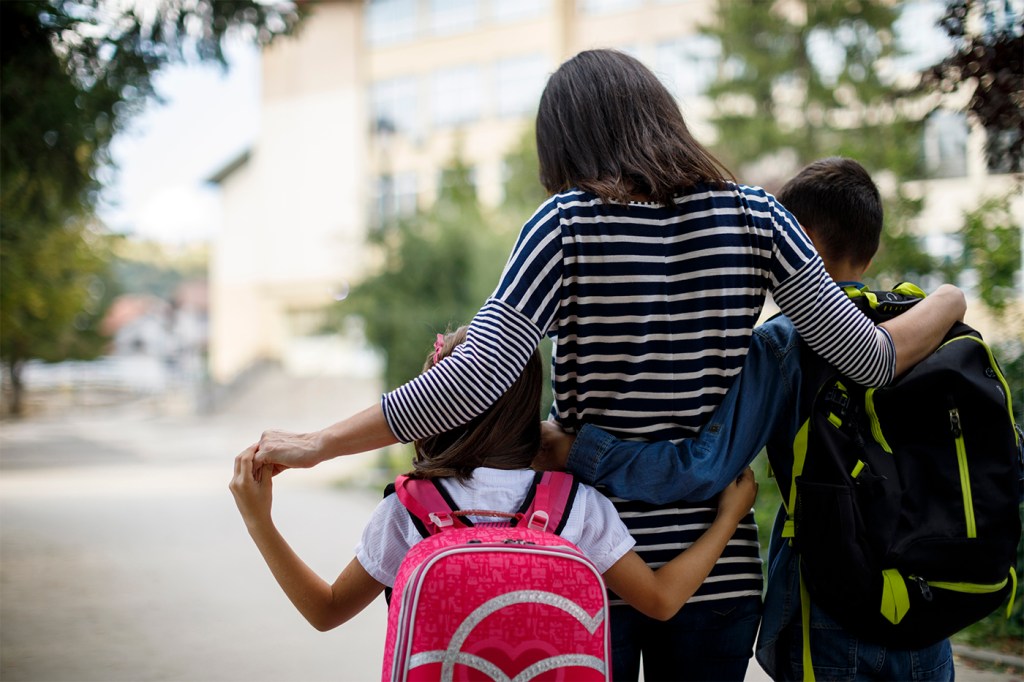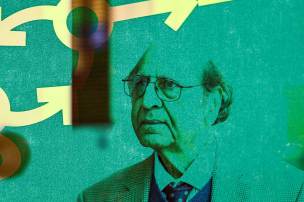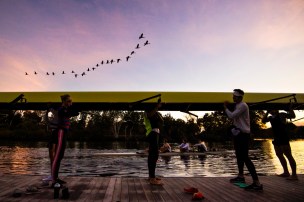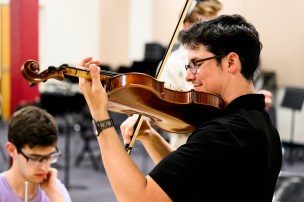Published on
Laurie Kramer makes a career of helping kids get along
To the benefit of parents the pioneering Northeastern psychologist studies how young children play (and fight).

It was no easy thing when Laurie Kramer began asking parents of young families to invite her into their homes.
She was pioneering a new area of clinical psychology focusing on the experiences of children 3 to 5 years old as they became siblings for the first time. It would emerge as Kramer’s specialty even though the timing, technologically, was difficult. She was launching her efforts in the pre-iPhone 1990s — the Betamax era of clumsy video equipment.
In those early groundbreaking days, she videotaped preschool-aged kids and their new baby siblings to study how exactly their relationships were formed. She was seeking to unravel the mysteries behind those interactions with an ultimate goal of developing tools that could help parents to develop positive relationships among their young children.
As renowned as Kramer has become in the study of sibling relationships, there remains in her a personal quality that empowers and transcends the cutting-edge research, a colleague says.
“It’s incredibly difficult work, it is intimidating for families, and so you have to be a trustworthy person and come to those interactions with genuine care,” says Christie Rizzo, associate professor of applied psychology at Northeastern. “Families pick up on when researchers are looking for data and maybe have lost focus on why they’re doing the work. And that is not Laurie: She’s really trying to do good work and help families and I think that is very much a reason why she’s been so successful.”
‘We’re going to be happier people’
Kramer studied initially for a career in physical therapy, having seen the benefits for elderly patients while she was volunteering at a nursing home. But that idea was quickly sidetracked.
“When they gave me a cat to dissect my first semester of college, I was out of there,” Kramer says. “And then at the end of the semester, after I did get through the course, they said, ‘Come back and we’ll give you a human to dissect’ — and I’m thinking, ‘I’ve got to find a different way to help people.’”

Kramer had been dissuaded from clinical psychology at that time because it was a competitive field with very few women. Her perspective changed as a graduate student at the University of Illinois when she proposed to study how children’s friendships can help them cope with divorce, which was a circumstance that happened to resonate with her. The dissertation was inspired by her adviser John Gottman, a famed psychologist who steered Kramer to the work of Judy Dunn, author of the 1982 book “Siblings: Love, Envy, and Understanding.”
Dunn’s book not only rebutted a prevailing theory that relationships among siblings were fraught with jealousy and rivalry — it also opened a door to the work that Kramer would take on to examine the many ways in which sibling relationships are critical contexts for children’s development.
“Judy was able to dispel a lot of myths,” Kramer says. “I basically adopted her longitudinal method of asking families if they would consider having me come to their home — to interview them, to do observe them talking with their kids, and to observe the kids playing with each other once the new baby was arrived. I added the focus on children’s friendships because emerging research demonstrated the critical support friends can provide during stressful events, even in early childhood.”
Her findings gave way to new studies. “And then we did some studies that were really fun, going into families’ homes and wiring kids up with wireless microphones, which was a new technology at that time,” says Kramer, professor of applied psychology and former director of the University Honors Program at Northeastern. “We made these little vests and embedded them with microphones, so we could hear what siblings really do together — and how parents actually respond when their children fight. It was both cute and informative.”
As part of this research, Kramer asked parents to fill out a questionnaire for their thoughts on the most effective responses to conflicts among their young children. Later, they would listen via a monitor placed in the kitchen as their kids — wearing those newfangled wireless microphones — would begin to argue.
“The parents had basically said that the best way to address children’s conflicts is to sit down with them, help each child to express their perspective and then guide the children through a process where they can find a mutually agreeable solution to their problem,” Kramer says. “Well, the observations showed the opposite. It was stunning that for the most part parents ignored the conflict. Even though we knew that they could hear their children argue, they chose not to intervene. What they thought was the most successful strategy was the thing that they did least often.
“The questionnaire responses revealed that parents know what they want to do, but they don’t have a lot of confidence to do it. Plus we know that it’s not that easy to go through this whole process of ‘collaborative problem-solving,’ which is what we were calling it. But we were able to show that when parents used that more effective method, indeed, the kids engaged in fewer conflicts and were more positive to each other.”
Kramer’s research showed that when kids were in the middle of extended conflicts — three or more negative exchanges involving two or more children — and the parents did nothing, then those conflicts continued.
“Very often conflicts did not stop on their own,” Kramer says. “That was a very important finding because a lot of parenting manuals say, ‘Don’t intervene in kids’ conflicts — you’re just rewarding those negative behaviors which will then increase.’ This in-home study looking at what parents really do demonstrated that ignoring sibling conflicts is not the most effective strategy, at least for kids under the age of 8. Young children need a caregiver to guide them through the conflict management process. And when that can’t occur, it is helpful for parents to at least acknowledge the conflict and ask children to try to work it out. Children may interpret parents’ ignoring of conflict as permission to fight.”
Another phase of Kramer’s research dealt with the friendships that children make beyond their families.
The quality of their friendships, the ways that they interacted with their friends, turned out to be one of the most significant predictors of how well they were going to get along with their siblings.
Laurie Kramer, professor of applied psychology and former director of the University Honors Program at Northeastern
Interested in how children’s relationships with their friends may be helpful as they became siblings, she positioned a cassette tape recorder in the room as the kids played, pretended, and bickered, without parents to intervene. These early friendships turned out to be highly revealing and led Kramer to develop new methods for helping siblings learn to interact positively and for parents to foster constructive social behaviors among their kids.
“I started looking at the firstborn child who was between the ages of 3 and 5 and have them schedule playdates with the child they considered to be their best friend,” Kramer says. “The quality of their friendships, the ways that they interacted with their friends, turned out to be one of the most significant predictors of how well they were going to get along with their siblings. I continued to examine this sibling-friend connection every time I visited the families until the elder child left for college. At every time-point the quality of that early friendship was even more powerful than the quality of relationship that they had with their mothers and fathers.”
Were these children able to stay on topic during connected conversations with friends? Could they coordinate their play with each other? Could they engage in pretend fantasy play over a period of time? Did they share confidences or exchange support?
“Being able to manage a positive emotional climate for their interactions was very important,” Kramer says. “It’s not like friends never fight. But when they do, the emotional level stays within certain parameters — you don’t often see huge emotional outbursts. Kids who were able to manage those conflicts were the ones who established the most positive relationships with their siblings.”
Children realize from an early age that their friendships must be earned and maintained. Learning to care for friends can help them form better relationships with their siblings.
“We realize that to keep our friends, we have to behave in certain ways,” Kramer says. “We have to be respectful. We have to not just think about our own needs, but we have to think about theirs as well. We have to learn how to manage disagreements. We have to use skills of perspective-taking — being excited for our friends when they’re excited and empathize when they’re not. And we have to have fun, right? Because if it’s not going to be fun, why would I want to be with a person?
“The research is suggesting that those competencies — perspective-taking, conflict management, maintaining a positive emotional climate — matter when it comes to developing successful sibling relationships. If we apply those competencies that we use successfully in our relationships with good friends to our relationships with our siblings, and maybe other people in our lives, we’re going to be happier people. We’re going to have richer relationships. And that’s going to pay off in terms of our mental health, and maybe in our physical health as well.”
‘See it your way, see it my way’
Annie Kramer, the child of Laurie and Art Kramer, believes her Boston practice as an employment lawyer helping workers receive their due benefits — “the social science area of the law,” as she puts it — has been influenced by her mother.
“I think that she has made me a very observant person,” Annie Kramer says. “I try to be really mindful of other people’s feelings. And I know that comes directly from her research, because I used to help my mom with her studies on Saturday mornings growing up.
“One of the things I will never forget is, ‘See it your way, see it my way,’” she says, referring to a phrase created by one of her mother’s students. Laurie Kramer embraced it as a motto of perspective that has helped teach kids as young as 3 to begin to develop a sense of empathy.
Laurie Kramer acknowledges that her research must have helped make her a better parent. This would place Annie among the first beneficiaries of her mother’s career.
“I think both of my parents have made me a hard worker,” Annie Kramer says. “Growing up, there were always discussions about my parents’ research at the dinner table, and you could just tell they really enjoyed what they were doing.”
Laurie and her future husband, Art, were undergrads when they met at Stony Brook University. As a psychology major, Art was doing experiments (not dissections) in the lab with a rat. “He named his rat after me,” Laurie Kramer says. “And so I knew he liked me.”
They were already married when they pursued Ph.D.s at the University of Illinois, where both would join the faculty. When the Kramers moved on after 37 years as students, professors, center and institute directors, and administrators (Laurie was the academic dean of her college), it was covered on the front page of the local press as the departure of an academic power couple. In his role as senior vice provost for research and graduate education at Northeastern, Art would help develop the Interdisciplinary Science and Engineering Complex, launch the Tier 1 program, and much more; Laurie would direct the University Honors Program and help advance interdisciplinary experiential education. (Art Kramer, a professor of psychology, now directs the Center for Cognitive and Brain Health at Northeastern.)
By moving to Boston, where Annie was settling after earning her law degree, the three Kramers were investing in their careers while reuniting geographically — a win-win that speaks to Laurie Kramer’s sense of priorities.
“I think I always had a very genuine interest in people, how they ticked and the relationships they form,” Kramer says. “What I tell my students is that I’m like the ‘queen of cognitive reframing’ — always trying to find something that we can hold on to that’s a positive way to look at a situation, an opportunity for growth or for change.
“It’s kind of like that old truism about crisis being an opportunity. Relationships are key. If we can help people build and sustain satisfying meaningful relationships, it’s going to help them in so many different ways.”
Kramer experienced such a crisis at 14 when her parents divorced. The impact was enduring.
“My sister and I were very close growing up, and I do believe that was part of the reason that we got through that fairly well,” says Kramer, who was the elder sibling by four years at their home in the Bronx, New York. “One day there was this divorce and we were like, ‘What happened? Why now? Why did this have to happen?’
“Probably,” she says, “that experience led me to my initial dissertation proposal.”
Circling back
Kramer has returned to teaching at Northeastern, which she describes as both renewing and inspiring.
“Laurie is well known nationally and globally for her research with siblings, which is really important — not enough of us work with families and children,” Rizzo says. “The recognition of her work and her talents is evidenced by all of the leadership roles that she has been appointed to and voted into.
“Personally, one of the things that stands out for me is she is such an incredible mentor. And that’s just not something that we’re trained to do, to support more junior faculty in reaching their career goals, but Laurie has a natural gift for being able to connect and hearing what your goals are and helping you get there. There’s not a lot of people that I can point to in my own life who are as good at that as she is.”
Kramer has taken another enterprising step by turning her research into action. She has helped create an online program for families with two children ages 4 to 8. The More Fun with Sisters and Brothers Program uses four online lessons to help parents teach their children to develop the social and emotional skills to build positive sibling relationships.
The program has drawn 30% of its users from outside the U.S. Having been limited by technology at the onset of her studies, Kramer’s work is now liberated by it.
“The data that we have right now is very positive,” says Kramer, who initially launched a similar in-person program for children. “It is showing that parents can be effective teachers of these competencies to their kids. From their reports, their children’s sibling relationships improved in terms of warmth and reducing conflict and rivalry and competition. The most stunning effect for us is that mothers are telling us that they feel more in control of their own emotions, less stressed by sibling strife, as a result of this program.”
Kramer’s next goal is to circle back to the families she researched when the children were young.
“These firstborn kids are in their late 30s now,” Kramer says. “As we go back and talk to these kids again, we will be asking them about their other relationships and seeing if there are connections. If they had a successful relationship with their sibling, way back when we first studied them, is it still successful? Does that relate to success in their other relationships?”
Ian Thomsen is a Northeastern Global News reporter. Email him at i.thomsen@northeastern.edu. Follow him on X/Twitter @IanatNU.






